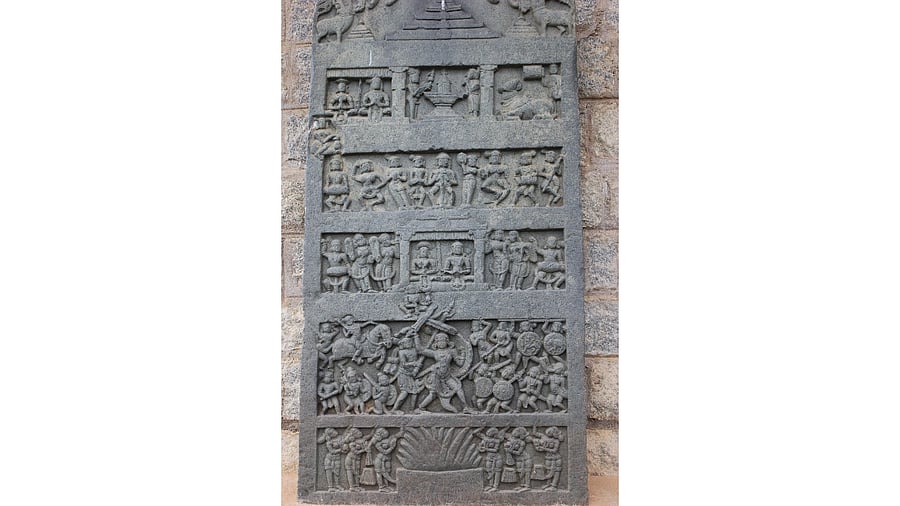
Hero stone dated 1160 CE at Kedarashvara temple in Belagavi.
Credit: Wikimedia Commons
As the skies reverberated with war drums and trumpeting elephants, the anointed warrior leapt into the fray, brandishing his sword to drive back his enemies. Suddenly pierced by an arrow, he fell to the ground; sharp blades rained on his sacred body, leaving him perished in blood-soaked dust. Death upon the battlefield was a noble one — his soul departed for the heavens with apsaras in company, no longer bound by earthly worries.
Back on earth, the valiant dead’s mortal remains were cremated, sometimes followed by the ritual suicide of wives and bodyguards. Their families received land, titles or wealth as compensation, and at the end of the mourning period, their overlord commissioned intricate memorial stones honouring the hero’s life and death. Strewn across western India and the Deccan, these sculptures, or hero stones, provide crucial information about life in medieval India.
Memorial hero stones are usually divided into three sections. The lowest panel depicts the nobleman’s final flourish in battle and eventual death — a visual record of the valour and military tactics of the time. These were sometimes accompanied by a scene of cremation, depicted alongside mourners and in some cases, sati (immolation of the wife atop her husband’s pyre). The second panel portrays the warrior’s ascendence to heaven and his afterlife, where he enjoys the rewards of bravery. The final segment at the top is dedicated to the family deity — very often Shiva represented by a linga, but also on occasion, a Jain Tirthankara.
Hero stones bear witness to the performance and commemoration of military activity in premodern South Asia. The battlefield was to the warrior what the court was to the poet — a space to not only demonstrate his prowess in front of the overlord but also an opportunity to cement his family name for posterity. Fearless warriors and women who accompanied them on the pyre were revered as family deities and their funerary memorials were worshipped with offerings of blood, rice, coconut and incense.
Of course, not all military activities in medieval India were large-scale battles resulting in impressive mortuary temples and hero stones. Skirmishes among small groups of raiders were frequent, with villagers usually trying to capture cattle — and sometimes women — or even water resources. Common foot soldiers could also not afford such memorials. Many combatants perished accidentally or were killed by wild animals, and these were then memorialised through single-panelled hero stones or small inscriptions. Steles were also commissioned to honour ritual beheadings, drownings or even live burials practised by the aristocracy and holy men alike. Yet other plaques honoured not humans but devoted pets who died serving their masters in battle or during hunts. No matter the purpose, the emotions evoked by the medieval martial imagery on these poignant hero stones are universal, reminding us that warfare, bravery and martyrdom have been around for as long as human life on earth.
Discover Indian Art is a monthly column that delves into fascinating stories on art from across the sub-continent, curated by the editors of the MAP Academy. Find them on Instagram as @map_academy